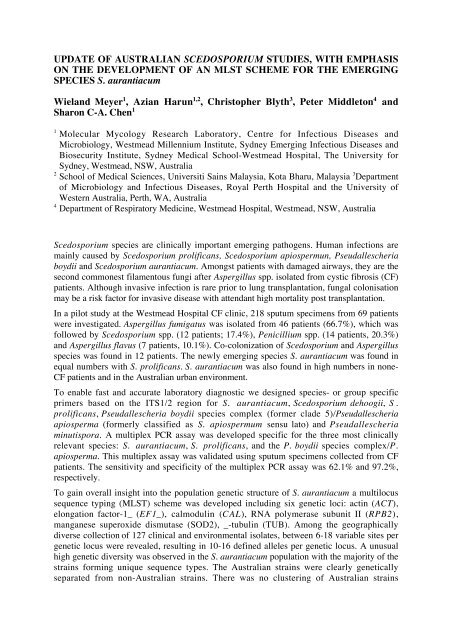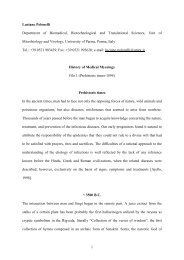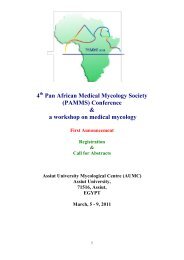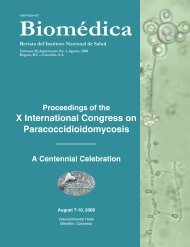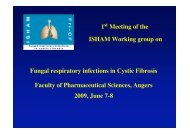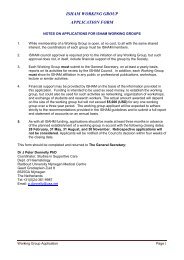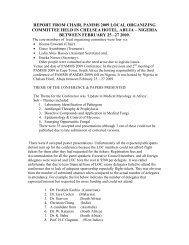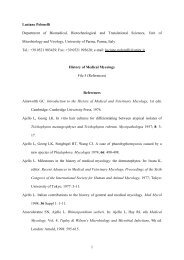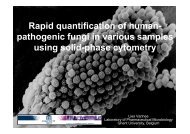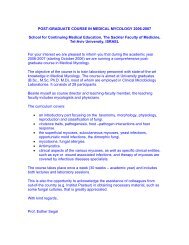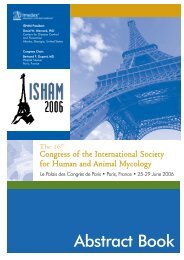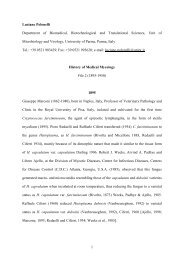Abstract book 2011 - ISHAM
Abstract book 2011 - ISHAM
Abstract book 2011 - ISHAM
Create successful ePaper yourself
Turn your PDF publications into a flip-book with our unique Google optimized e-Paper software.
UPDATE OF AUSTRALIAN SCEDOSPORIUM STUDIES, WITH EMPHASISON THE DEVELOPMENT OF AN MLST SCHEME FOR THE EMERGINGSPECIES S. aurantiacumWieland Meyer 1 , Azian Harun 1,2 , Christopher Blyth 3 , Peter Middleton 4 andSharon C-A. Chen 11 Molecular Mycology Research Laboratory, Centre for Infectious Diseases andMicrobiology, Westmead Millennium Institute, Sydney Emerging Infectious Diseases andBiosecurity Institute, Sydney Medical School-Westmead Hospital, The University forSydney, Westmead, NSW, Australia2 School of Medical Sciences, Universiti Sains Malaysia, Kota Bharu, Malaysia 3 Departmentof Microbiology and Infectious Diseases, Royal Perth Hospital and the University ofWestern Australia, Perth, WA, Australia4 Department of Respiratory Medicine, Westmead Hospital, Westmead, NSW, AustraliaScedosporium species are clinically important emerging pathogens. Human infections aremainly caused by Scedosporium prolificans, Scedosporium apiospermun, Pseudallescheriaboydii and Scedosporium aurantiacum. Amongst patients with damaged airways, they are thesecond commonest filamentous fungi after Aspergillus spp. isolated from cystic fibrosis (CF)patients. Although invasive infection is rare prior to lung transplantation, fungal colonisationmay be a risk factor for invasive disease with attendant high mortality post transplantation.In a pilot study at the Westmead Hospital CF clinic, 218 sputum specimens from 69 patientswere investigated. Aspergillus fumigatus was isolated from 46 patients (66.7%), which wasfollowed by Scedosporium spp. (12 patients; 17.4%), Penicillium spp. (14 patients, 20.3%)and Aspergillus flavus (7 patients, 10.1%). Co-colonization of Scedosporium and Aspergillusspecies was found in 12 patients. The newly emerging species S. aurantiacum was found inequal numbers with S. prolificans. S. aurantiacum was also found in high numbers in none-CF patients and in the Australian urban environment.To enable fast and accurate laboratory diagnostic we designed species- or group specificprimers based on the ITS1/2 region for S. aurantiacum, Scedosporium dehoogii, S.prolificans, Pseudallescheria boydii species complex (former clade 5)/Pseudallescheriaapiosperma (formerly classified as S. apiospermum sensu lato) and Pseudallescheriaminutispora. A multiplex PCR assay was developed specific for the three most clinicallyrelevant species: S. aurantiacum, S. prolificans, and the P. boydii species complex/P.apiosperma. This multiplex assay was validated using sputum specimens collected from CFpatients. The sensitivity and specificity of the multiplex PCR assay was 62.1% and 97.2%,respectively.To gain overall insight into the population genetic structure of S. aurantiacum a multilocussequence typing (MLST) scheme was developed including six genetic loci: actin (ACT),elongation factor-1_ (EF1_), calmodulin (CAL), RNA polymerase subunit II (RPB2),manganese superoxide dismutase (SOD2), _-tubulin (TUB). Among the geographicallydiverse collection of 127 clinical and environmental isolates, between 6-18 variable sites pergenetic locus were revealed, resulting in 10-16 defined alleles per genetic locus. A unusualhigh genetic diversity was observed in the S. aurantiacum population with the majority of thestrains forming unique sequence types. The Australian strains were clearly geneticallyseparated from non-Australian strains. There was no clustering of Australian strains


